Research on Cooperative Perception of MUSVs in Complex Ocean Conditions
Abstract
1. Introduction
2. Cooperative Perception Architecture
- Uncertain events detection module: The possible obstacle-dense events, mobile vessel emergence events, course deviation events, key point unreachability events, deadlock events, etc. of MUSVs navigating in complex ocean environment will affect the safety of USV themselves. On the basis of fully summarizing and organizing uncertain events, we further analyze the causal relationship between uncertain events and formation navigation, and clarify the strategy for handling uncertain events, so as to provide a basis for USV formation navigation and cooperative collision avoidance planning. Firstly, the event state information from the uncertain event ontology is fuzzy quantified, and the quantified information is compared, analyzed and judged with the historical events and the event feature template in the domain, so as to calculate the probability of occurrence of the uncertain event.
- Collision Avoidance Pattern Recognition Module: Extracts useful information from the raw data observed by the sensors and generates instances of certain concepts in the USV ontology, environment ontology, and uncertain event ontology. The new instances are then reasoned with rules and Abox to determine whether they are instances of key elements or events. If a key element or event instance is generated, the collision avoidance pattern processing module is triggered, and the OntoBayes method is used to apply Bayesian networks to the collision avoidance pattern ontology, and the degree of influence of uncertain events on the collision avoidance pattern is determined by using the Bayesian network inference algorithm to finally determine the collision avoidance pattern that MUSVs should take, and the identification results are stored in the collision avoidance pattern ontology.
- Environmental ontology model: The purpose of environmental information ontology modeling for MUSVs is to represent the knowledge of environmental information for MUSVs using an ontology approach. Four ontologies can be established: USV ontology, environment ontology, uncertainty event ontology and collision avoidance pattern ontology. the USV ontology is used to describe the information of the USV platform itself, involving concepts such as position, attitude, velocity, direction of motion, other USV information and other USV system operating states; the environment ontology is used to describe the working environment in which the USV is located, and the main concepts are working area, key point, target point, obstruction, sea wind, waves, currents, visibility, etc. The uncertain event ontology is used to describe the uncertain event information that affects the formation of MUSVs, and involves concepts such as event name, event type, event probability, and event impact on each USV. In addition, the collision avoidance pattern ontology is used to describe the collision avoidance pattern that USVs should adopt according to the environmental perception results, including overall collision avoidance pattern, group collision avoidance pattern, and individual collision avoidance pattern, involving concepts such as pattern type, group number, and group member information.
3. Ontology Modeling of Environmental Information
4. MUSVs Cooperative Perception Method Based on Ontology and Bayesian Network Theory
4.1. Uncertain Event Detection
4.2. Collision Avoidance Pattern Recognition Method for MUSVs Based on Bayesian Network Theory
5. Navigation Task Cooperative Perception Simulation Experiment
6. Conclusions
Author Contributions
Funding
Institutional Review Board Statement
Informed Consent Statement
Data Availability Statement
Conflicts of Interest
References
- Zhang, R.; Wen, N.; Yu, H.; Wang, L.; Wu, J.; Liu, G. USVs Cooperative Collision Avoidance Based on Man–Machine Interaction and the Artificial Potential Field Method. In Proceedings of the 2019 Chinese Automation Congress (CAC), Hangzhou, China, 22 November 2019; pp. 1552–1557. [Google Scholar]
- Felski, A.; Zwolak, K. The Ocean-Going Autonomous Ship-Challenges and Threats. J. Mar. Sci. Eng. 2020, 8, 41. [Google Scholar] [CrossRef]
- Jorge, V.A.; Granada, R.; Maidana, R.G.; Jurak, D.A.; Heck, G.; Negreiros, A.P.; Dos Santos, D.H.; Gonçalves, L.M.; Amory, A.M. A survey on unmanned surface vehicles for disaster robotics: Main challenges and directions. Sensors 2019, 19, 702. [Google Scholar] [CrossRef] [PubMed]
- Campbell, S.; Naeem, W.; Irwin, G.W. A review on improving the autonomy of unmanned surface vehicles through intelligent collision avoidance manoeuvres. Annu. Rev. Control 2012, 36, 267–283. [Google Scholar] [CrossRef]
- Xin, J.; Zhong, J.; Li, S.; Sheng, J.; Cui, Y. Greedy mechanism based particle swarm optimization for path planning problem of an unmanned surface vehicle. Sensors 2019, 19, 4620. [Google Scholar] [CrossRef] [PubMed]
- Cho, H.; Jeong, S.K.; Ji, D.H.; Tran, N.H.; Choi, H.S. Study on control system of integrated unmanned surface vehicle and underwater vehicle. Sensors 2020, 20, 2633. [Google Scholar] [CrossRef] [PubMed]
- Lane, D.; Brown, K.; Petillot, Y.; Miguelanez, E.; Patron, P. An Ontology-Based Approach to Fault Tolerant Mission Execution for Autonomous Platforms. Marine Robot Autonomy; Springer: Berlin/Heidelberg, Germany, 2013; pp. 225–255. [Google Scholar]
- Leite, A.; Girardi, R.; Novais, P. Using Ontologies in Hybrid Software Agent Architectures. In Proceedings of the IEEE/WIC/ACM International Joint Conferences on Web Intelligence and Intelligent Agent Technologies, Atlanta, GA, USA, 17 November 2013; pp. 155–158. [Google Scholar]
- Migueláñez, E.; Patrón, P.; Brown, K.E.; Petillot, Y.R. Semantic Knowledge-Based Framework to Improve the Situation Awareness of Autonomous Underwater Vehicles. IEEE Trans. Knowl. Eng. 2011, 23, 759–773. [Google Scholar] [CrossRef]
- Gao, W.; Yang, J.; Liu, J.; Xu, B.; Yang, J.W. Cooperative localization algorithm for multi-surface unmanned boats considering communication delay. J. Harbin Eng. Univ. 2013, 34, 1491–1513. [Google Scholar]
- Li, Y.; Wang, Y.; Yu, W.; Guan, X. Multiple autonomous underwater vehicle cooperative localization in anchor-free environments. IEEE J. Ocean. Eng. 2019, 44, 895–911. [Google Scholar] [CrossRef]
- Fallon, M.F.; Papadopoulos, G.; Leonard, J.J. A Measurement Distribution Framework for Cooperative Navigation using Multiple AUVs. In Proceedings of the 2010 IEEE International Conference on Robotics and Automation, Anchorage, AK, USA, 3 May 2010. [Google Scholar]
- Zhang, R.B.; Yin, L.L.; Gu, H.W. Research on AUV environment sensing method in uncertain ocean environment. Comput. Res. Dev. 2013, 50, 1981–1991. [Google Scholar]
- Yin, L.; Gu, H.; Zhang, R.; Xie, W.; Zhao, Q.; Zhang, Y. Research on Ontology Modeling of Uncertain Environment Cognition for Unmanned Maritime Systems. In Proceedings of the 2018 Chinese Automation Congress (CAC), Xi’an, China, 2 July 2018; pp. 2699–2704. [Google Scholar] [CrossRef]
- Marzoughi, A.; Savkin, A.V. Autonomous Navigation of a Team of Unmanned Surface Vehicles for Intercepting Intruders on a Region Boundary. Sensors 2021, 21, 297. [Google Scholar] [CrossRef] [PubMed]

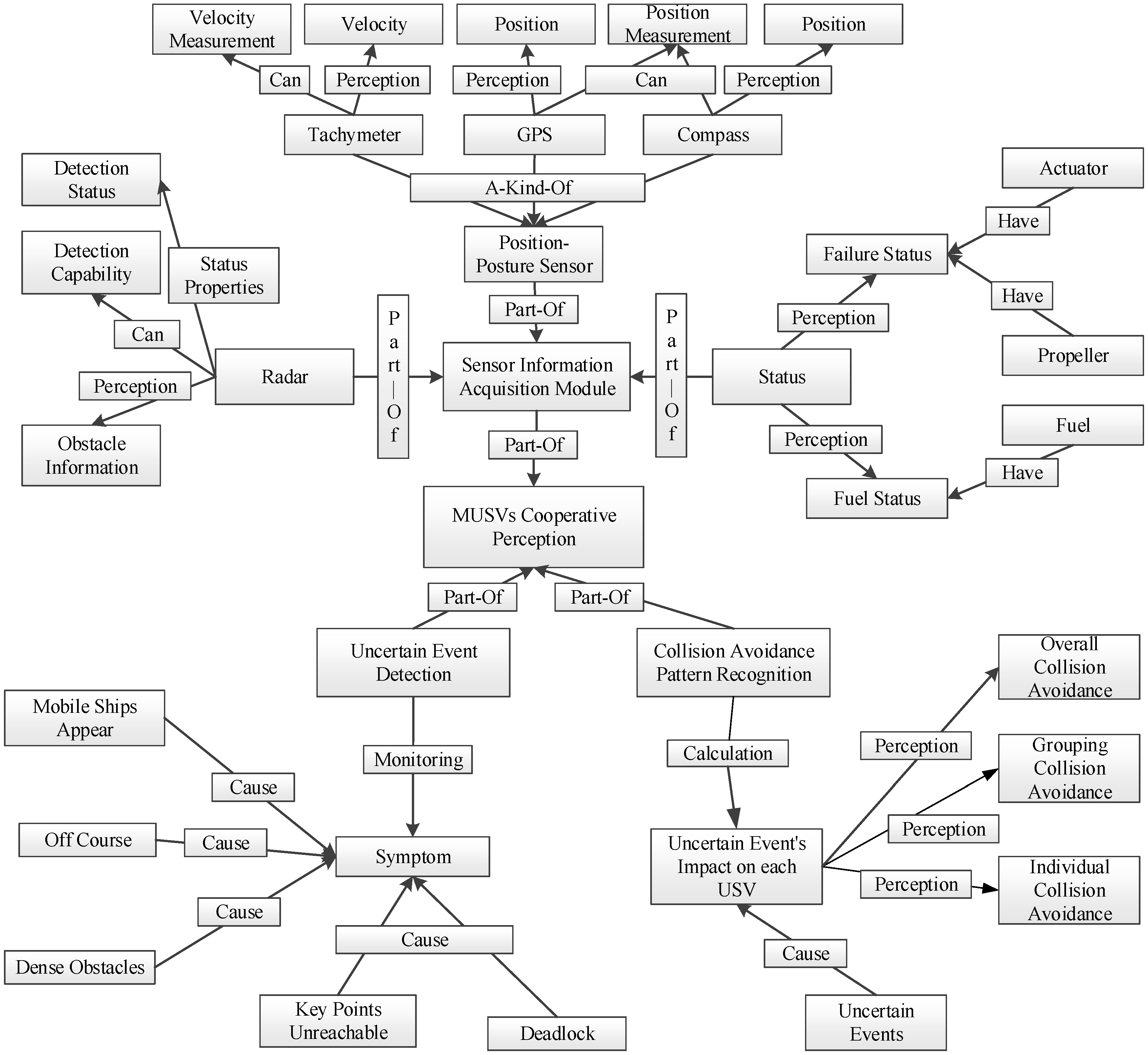
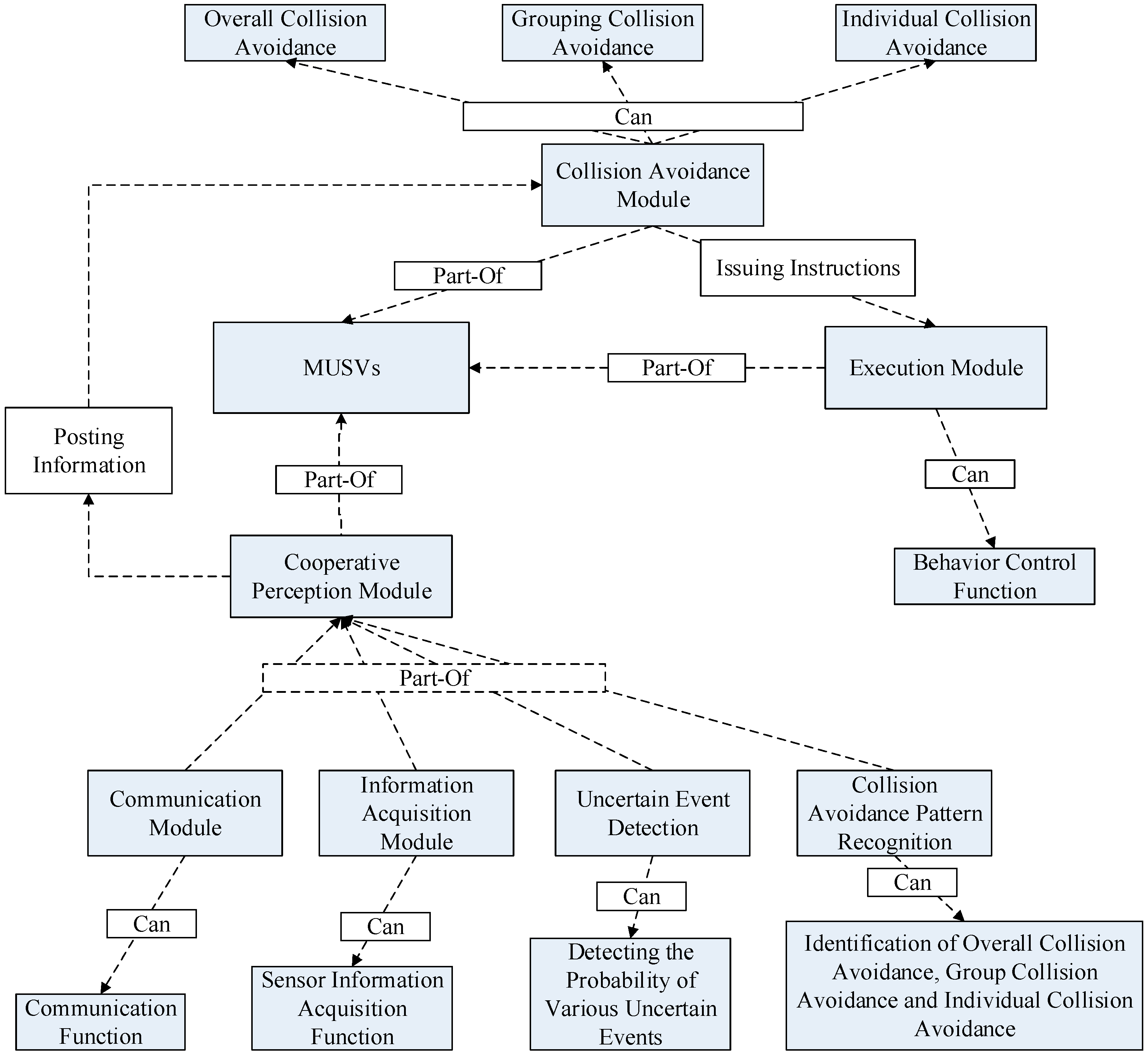

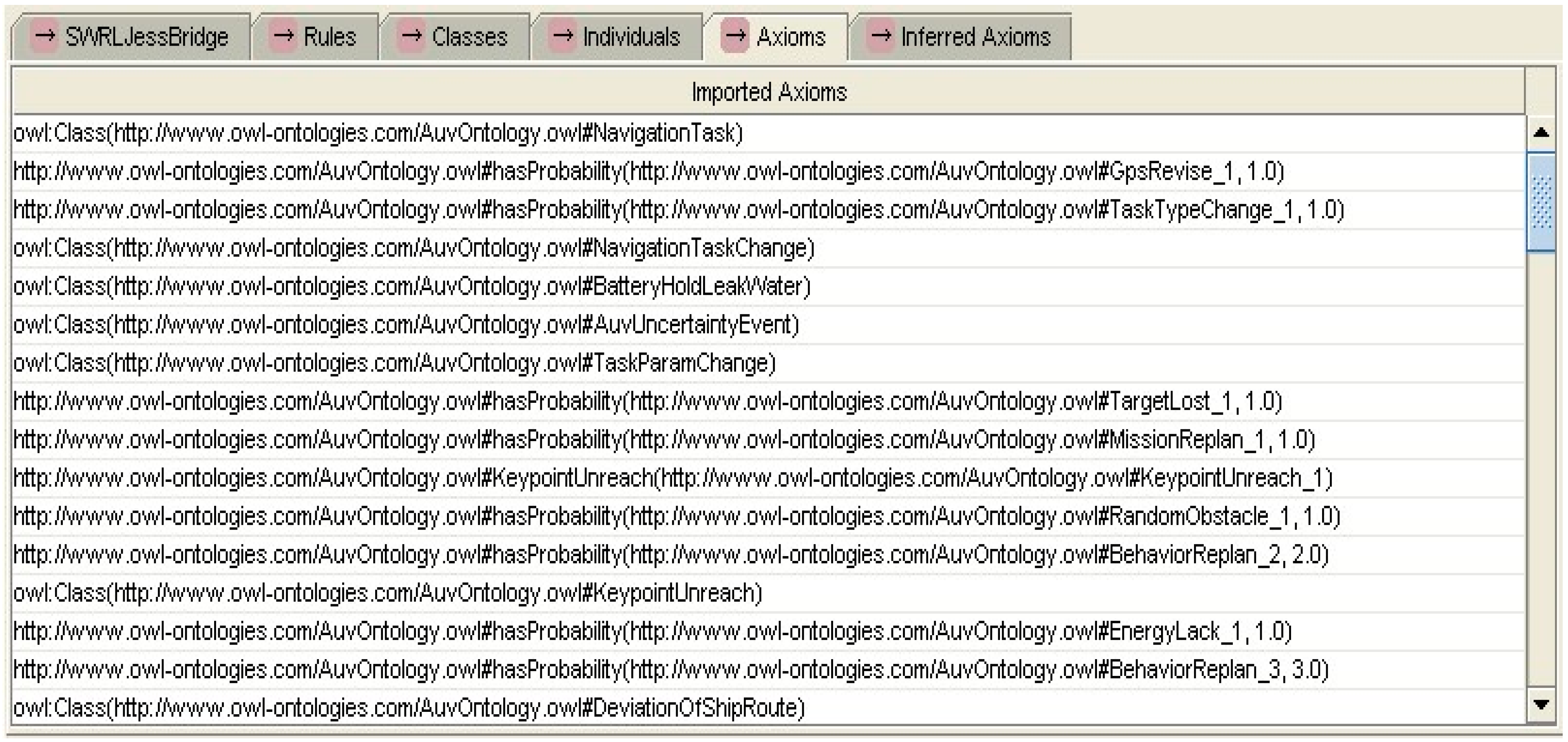
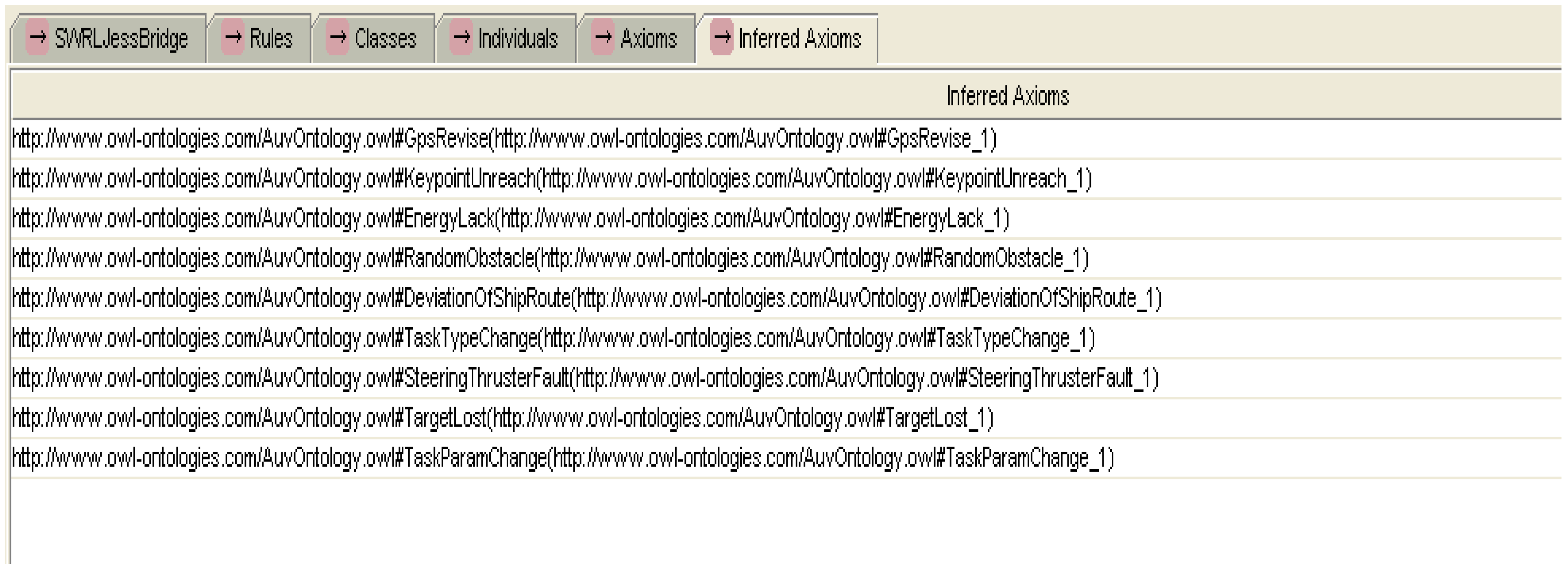

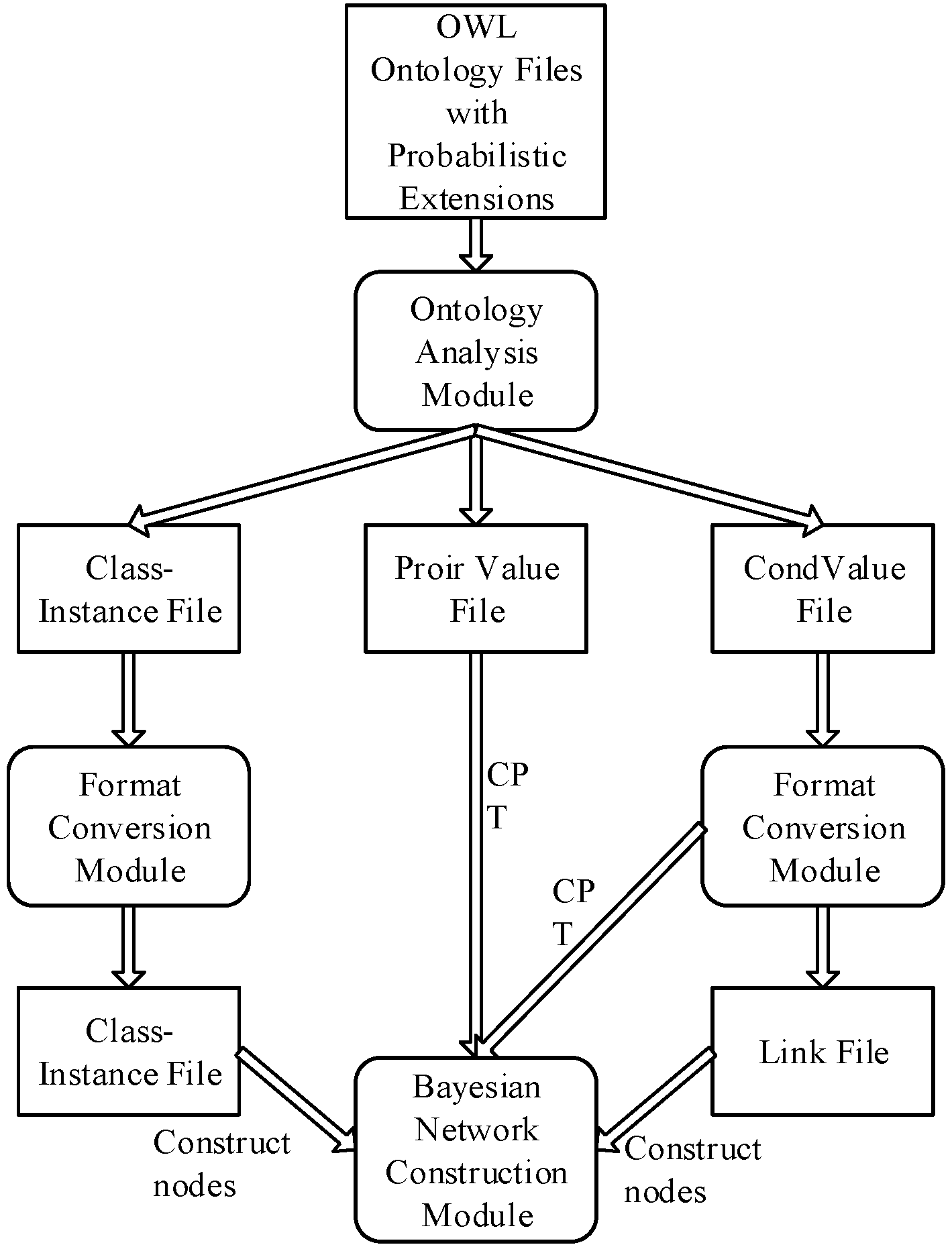
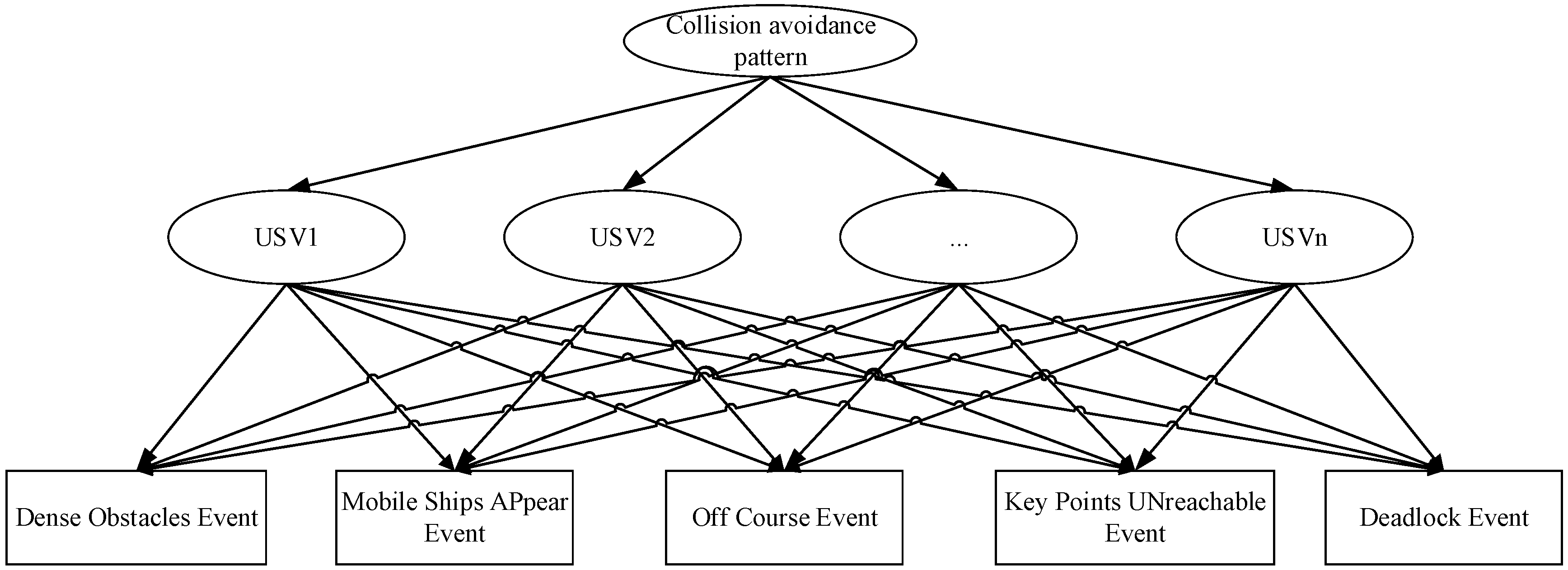

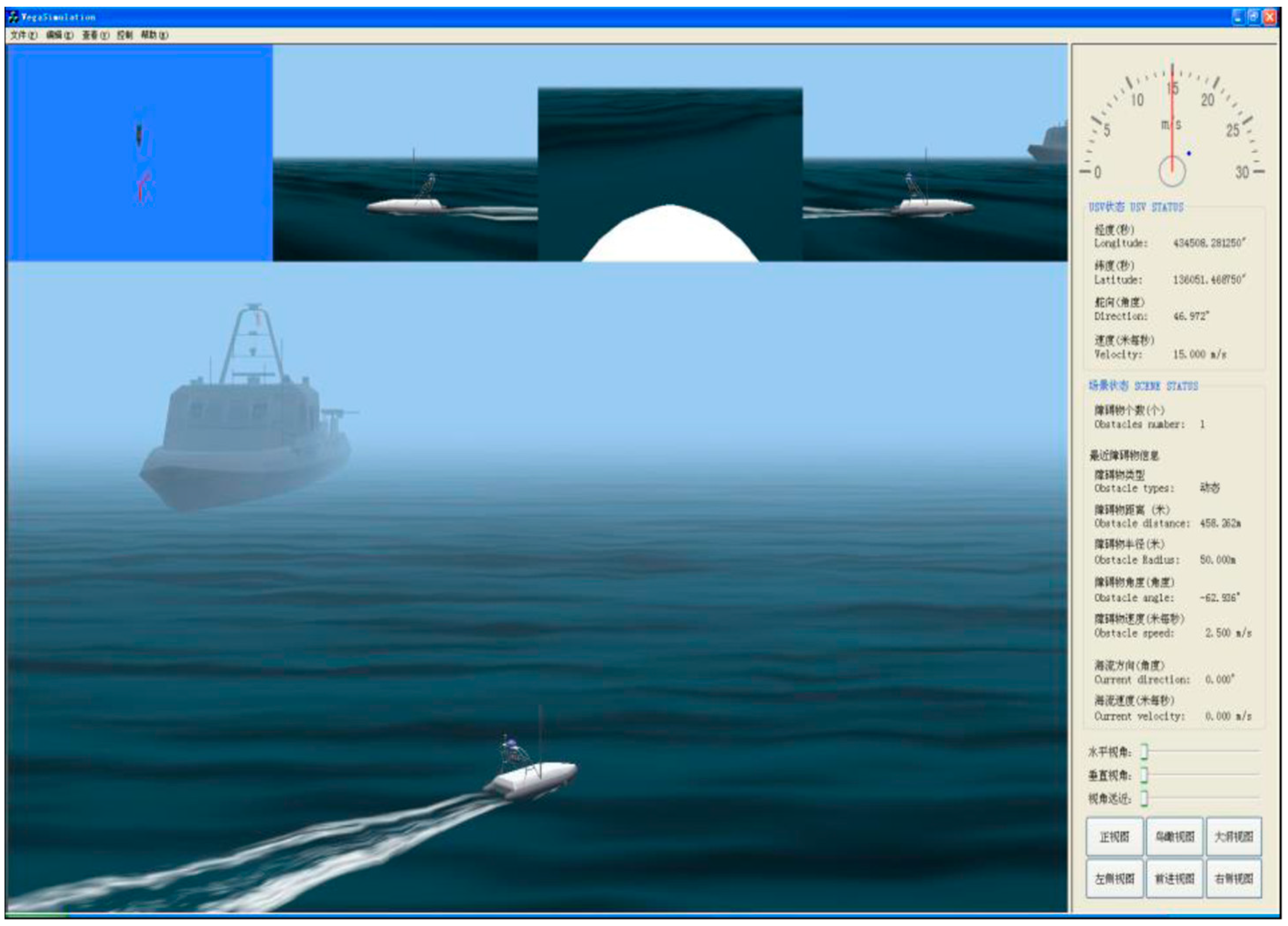
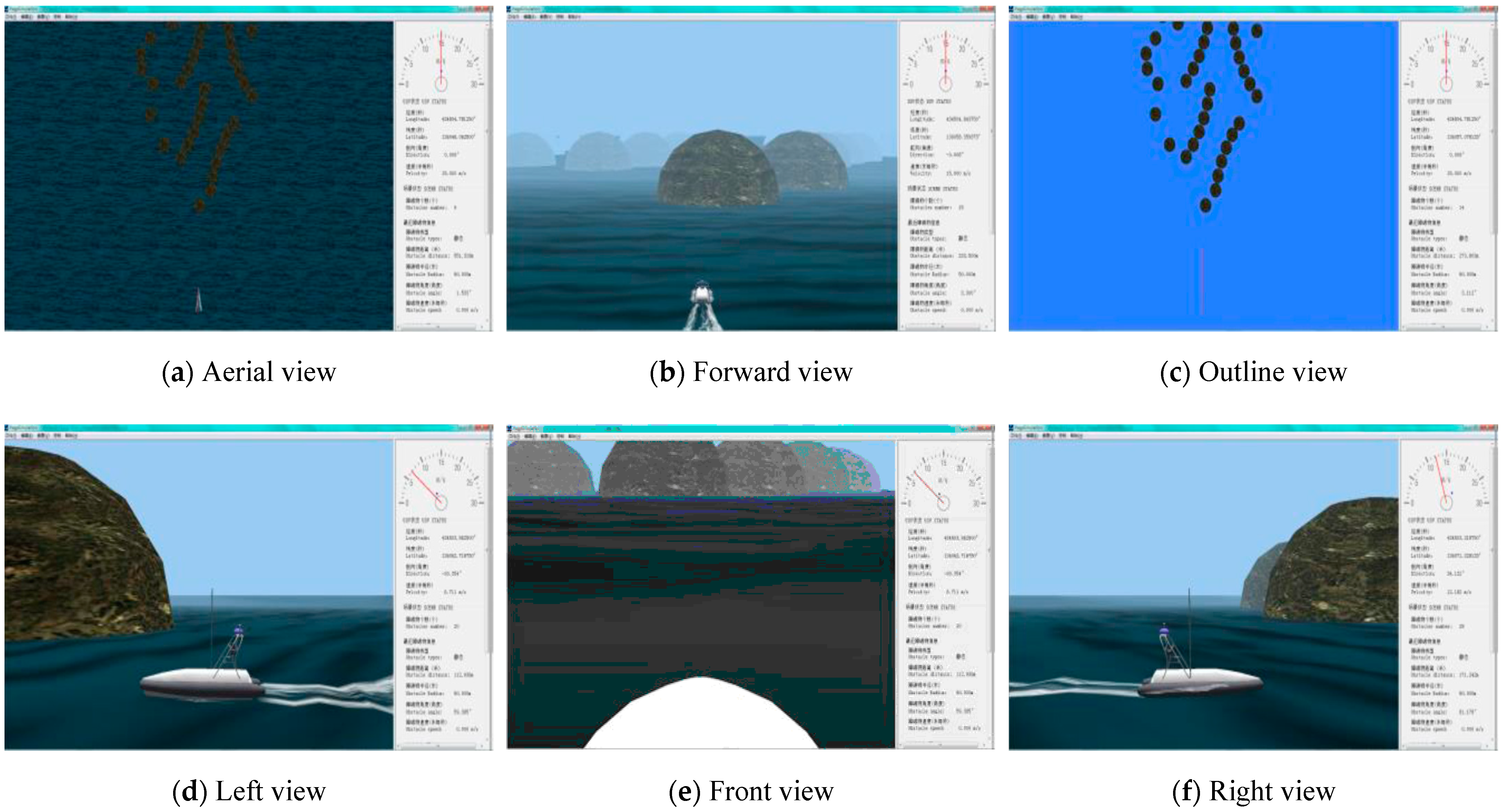

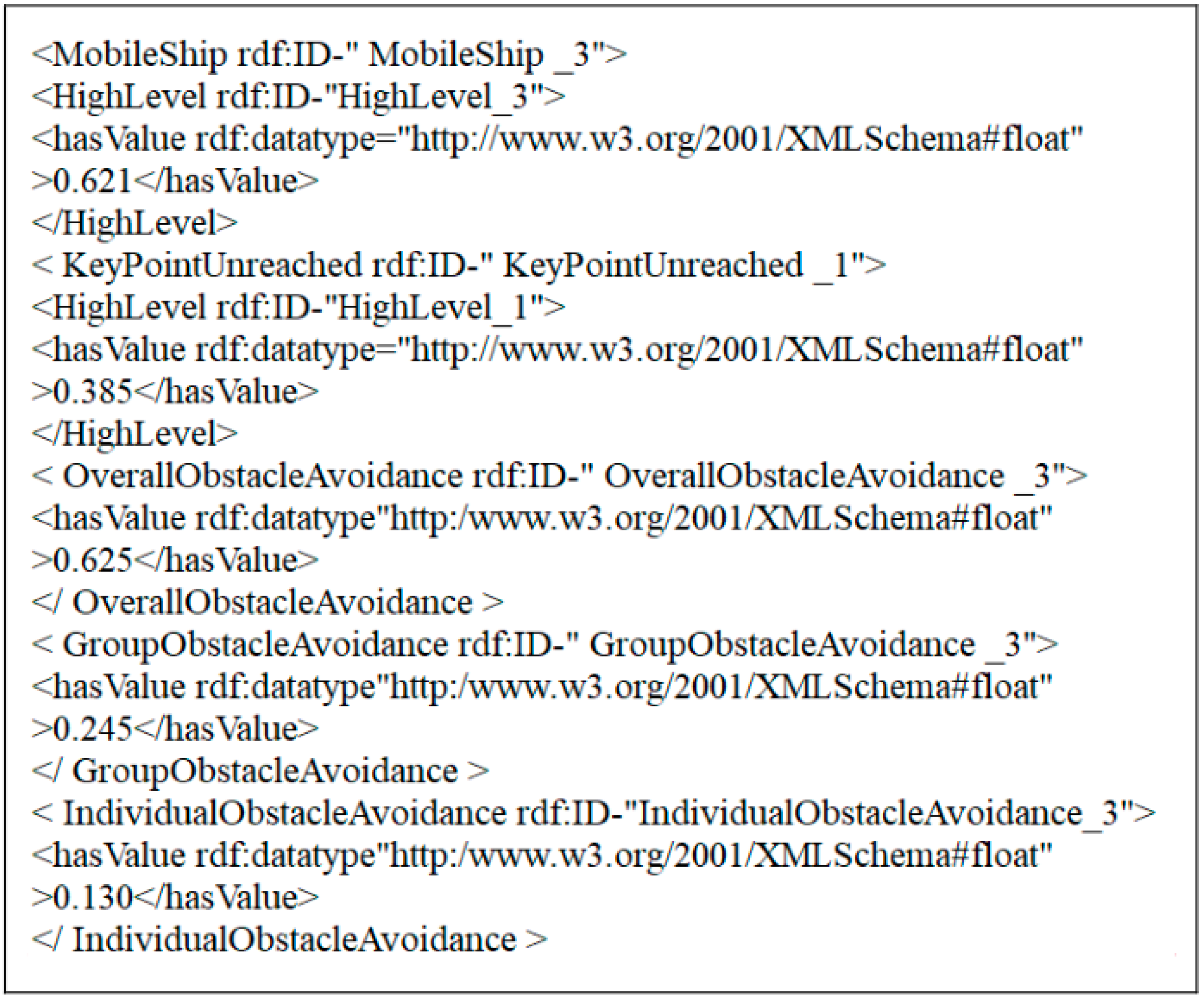
| Rule Name | Regular Expression |
|---|---|
| Rule 1 | Even(?x) Λ Disto (?y) Λ hasDistance (?y,?z) Λ swrlb:lessThan(?z,70)→MobileShipAppears (?x) |
| Rule 2 | Event(?x) Λ hasState(?x, ?y) Λ State(?y) Λ hasValue(?y, ?z) Λ swrlb:greaterThan(?z, 0)→KeyPointNotReachable (?x) |
| Rule 3 | Event(?x) Λ hasDeviation(?x, ?y) Λ Deviation(?y) Λ hasDistance (?y, ?z) Λ swrlb:greaterThan(?z, 10)→OffCourse (?x) |
| Rule 4 | Event(?x) Λ hasState(?x, ?y) Λ State(?y) Λ hasValue(?y, ?z) Λ swrlb:greaterThan(?z, 0y)→Deadlock(?x) |
| Rule 5 | Event(?x) Λ Dense(?y) Λ hasCollisionRisk(?y, ?z) Λ swrlb:greaterThan(?z, 0.6)→DenseObstacles (?x) |
| Dense Obstacles | Mobile Ship Appears | Off Course | Key Point Not Reachable | Deadlock | ||||||||||
|---|---|---|---|---|---|---|---|---|---|---|---|---|---|---|
| High | Medium | Low | High | Medium | Low | High | Medium | Low | High | Medium | Low | Yes | No | |
| High | 0.7 | 0.2 | 0.1 | 0.8 | 0.1 | 0.1 | 0.6 | 0.3 | 0.1 | 0.8 | 0.1 | 0.1 | 0.8 | 0.2 |
| Medium | 0.6 | 0.3 | 0.1 | 0.6 | 0.2 | 0.2 | 0.2 | 0.4 | 0.4 | 0.7 | 0.2 | 0.1 | 0.6 | 0.4 |
| Low | 0.1 | 0.3 | 0.6 | 0.1 | 0.2 | 0.7 | 0.1 | 0.3 | 0.6 | 0.2 | 0.2 | 0.6 | 0.2 | 0.8 |
| Time (s) | Event Name | Event Probability | Overall Collision Avoidance Probability | Grouping Collision Avoidance Probability | Individual Collision Avoidance Probability |
|---|---|---|---|---|---|
| 100 | Mobile ship appeared event | 0.723 | 0.116 | 0.653 | 0.231 |
| 101 | Mobile ship appeared event | 0.809 | 0.184 | 0.724 | 0.092 |
| 102 | Mobile ship appeared event | 0.728 | 0.119 | 0.643 | 0.238 |
| 103 | Mobile ship appeared event | 0.465 | 0.143 | 0.58 | 0.277 |
| 104 | Mobile ship appeared event | 0.448 | 0.133 | 0.3 | 0.567 |
| 105 | Mobile ship appeared event | 0.309 | 0.223 | 0.312 | 0.465 |
| 106 | Mobile ship appeared event | 0.191 | 0.296 | 0.313 | 0.391 |
| 107 | Mobile ship appeared event | 0.000 | 0.3 | 0.4 | 0.3 |
| Time (s) | Event Name | Event Probability | Overall Collision Avoidance Probability | Grouping Collision Avoidance Probability | Individual Collision Avoidance Probability |
|---|---|---|---|---|---|
| 114 | Mobile ship appeared event | 0.358 | 0.305 | 0.422 | 0.273 |
| Key point unreached event | 0.000 | ||||
| 115 | Mobile ship appeared event | 0.557 | 0.462 | 0.458 | 0.358 |
| Key point unreached event | 0.000 | ||||
| 116 | Mobile ship appeared event | 0.621 | 0.625 | 0.245 | 0.130 |
| Key point unreached event | 0.385 | ||||
| 117 | Mobile ship appeared event | 0.693 | 0.763 | 0.163 | 0.074 |
| Key point unreached event | 0.627 | ||||
| 118 | Mobile ship appeared event | 0.593 | 0.641 | 0.254 | 0.105 |
| Key point unreached event | 0.521 | ||||
| 119 | Mobile ship appeared event | 0.358 | 0.445 | 0.372 | 0.183 |
| Key point unreached event | 0.417 | ||||
| 124 | Mobile ship appeared event | 0.089 | 0.300 | 0.400 | 0.300 |
| Key point unreached event | 0.124 |
Publisher’s Note: MDPI stays neutral with regard to jurisdictional claims in published maps and institutional affiliations. |
© 2021 by the authors. Licensee MDPI, Basel, Switzerland. This article is an open access article distributed under the terms and conditions of the Creative Commons Attribution (CC BY) license (http://creativecommons.org/licenses/by/4.0/).
Share and Cite
Yin, L.; Zhang, R.; Gu, H.; Li, P. Research on Cooperative Perception of MUSVs in Complex Ocean Conditions. Sensors 2021, 21, 1657. https://doi.org/10.3390/s21051657
Yin L, Zhang R, Gu H, Li P. Research on Cooperative Perception of MUSVs in Complex Ocean Conditions. Sensors. 2021; 21(5):1657. https://doi.org/10.3390/s21051657
Chicago/Turabian StyleYin, Lili, Rubo Zhang, Hengwen Gu, and Peng Li. 2021. "Research on Cooperative Perception of MUSVs in Complex Ocean Conditions" Sensors 21, no. 5: 1657. https://doi.org/10.3390/s21051657
APA StyleYin, L., Zhang, R., Gu, H., & Li, P. (2021). Research on Cooperative Perception of MUSVs in Complex Ocean Conditions. Sensors, 21(5), 1657. https://doi.org/10.3390/s21051657







